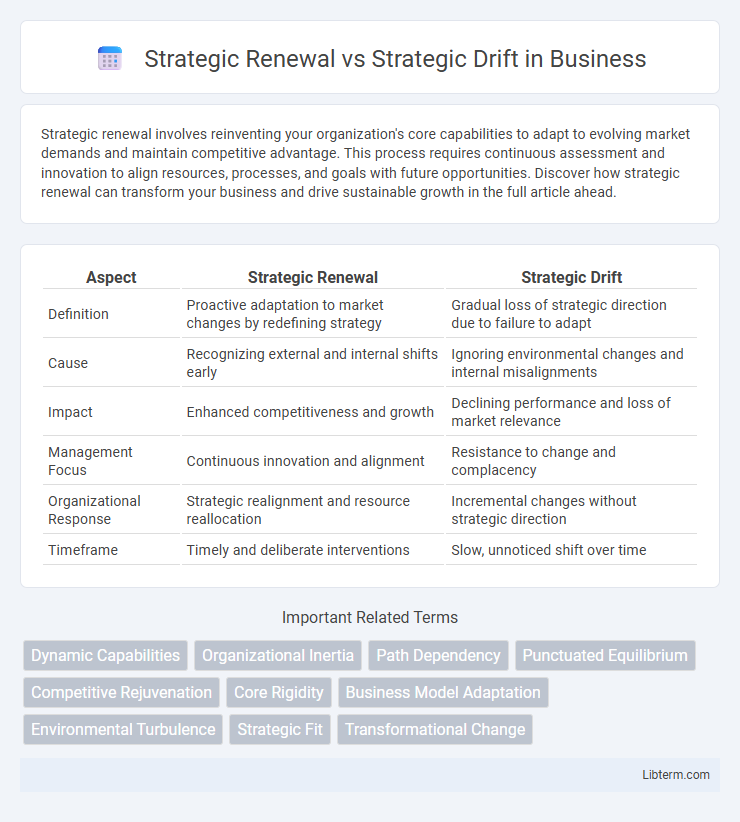Strategic renewal involves reinventing your organization's core capabilities to adapt to evolving market demands and maintain competitive advantage. This process requires continuous assessment and innovation to align resources, processes, and goals with future opportunities. Discover how strategic renewal can transform your business and drive sustainable growth in the full article ahead.
Table of Comparison
| Aspect | Strategic Renewal | Strategic Drift |
|---|---|---|
| Definition | Proactive adaptation to market changes by redefining strategy | Gradual loss of strategic direction due to failure to adapt |
| Cause | Recognizing external and internal shifts early | Ignoring environmental changes and internal misalignments |
| Impact | Enhanced competitiveness and growth | Declining performance and loss of market relevance |
| Management Focus | Continuous innovation and alignment | Resistance to change and complacency |
| Organizational Response | Strategic realignment and resource reallocation | Incremental changes without strategic direction |
| Timeframe | Timely and deliberate interventions | Slow, unnoticed shift over time |
Understanding Strategic Renewal: Definition and Importance
Strategic renewal involves the deliberate process of redefining an organization's vision, capabilities, and market positioning to adapt to dynamic external environments and maintain competitive advantage. It is crucial for companies to continuously engage in strategic renewal to respond effectively to technological advancements, shifting consumer preferences, and emerging market trends. Failing to implement strategic renewal can result in strategic drift, where an organization's strategy becomes misaligned with external realities, leading to performance decline and loss of market relevance.
What is Strategic Drift?
Strategic Drift occurs when an organization's strategy gradually becomes misaligned with changes in the external environment, leading to a decline in performance. This phenomenon typically arises from incremental decision-making that fails to address significant market shifts, technological advancements, or competitive pressures. Identifying early signs of Strategic Drift is crucial for realigning strategic initiatives and maintaining organizational relevance.
Key Differences Between Strategic Renewal and Strategic Drift
Strategic renewal involves proactive adaptation and innovation to align an organization's strategies with changing market conditions, while strategic drift results from gradual misalignment due to neglecting external environmental shifts. Key differences include the organization's responsiveness, where strategic renewal emphasizes continuous monitoring and adjustment, whereas strategic drift is marked by inertia and resistance to change. Furthermore, strategic renewal fosters sustainable competitive advantage through deliberate transformation, contrasting with strategic drift's decline stemming from strategic stagnation.
Causes and Triggers of Strategic Drift
Strategic drift occurs when an organization fails to adapt its strategy to changing external environments, often due to complacency, rigid organizational culture, or inadequate market sensing capabilities. Causes of strategic drift include leadership inertia, overreliance on past successes, and misalignment between strategy and emerging industry trends or technological advancements. Triggers for strategic renewal involve recognizing performance gaps, market disruptions, or shifts in consumer behavior that demand proactive strategic realignment and innovation.
Drivers and Enablers of Strategic Renewal
Strategic renewal is driven by proactive leadership commitment, continuous environmental scanning, and adaptive organizational culture that embraces change and innovation. Key enablers include dynamic capabilities such as knowledge management, flexible resource allocation, and stakeholder engagement that facilitate strategic realignment. Unlike strategic drift, where organizations fail to respond to external shifts, strategic renewal leverages these drivers and enablers to maintain competitive advantage and organizational resilience.
Signs Your Organization is Experiencing Strategic Drift
Signs your organization is experiencing strategic drift include a failure to respond to market changes, declining performance metrics, and a misalignment between strategy and execution. Indicators such as reduced customer satisfaction, increased operational inefficiencies, and consistent loss of competitive advantage signal the need for strategic renewal. Monitoring market trends, employee feedback, and financial health can help identify strategic drift before it undermines organizational success.
The Role of Leadership in Managing Strategic Change
Leadership plays a crucial role in managing strategic change by actively recognizing the need for strategic renewal to avoid strategic drift. Effective leaders foster a culture of adaptability and continuous learning, ensuring the organization remains aligned with evolving market conditions and technological advancements. By promoting clear vision and decisive action, leadership mitigates the risks of complacency and misalignment, enabling timely strategic adjustments.
Strategies to Prevent Strategic Drift
Implementing continuous environmental scanning and fostering a culture of strategic flexibility are key strategies to prevent strategic drift. Organizations should prioritize regular performance reviews aligned with changing market dynamics and invest in leadership development to enhance adaptive decision-making. Emphasizing proactive innovation and aligning resources with emerging opportunities ensures sustained strategic renewal and competitive advantage.
Case Studies: Strategic Renewal vs Strategic Drift
Case studies highlight companies like Nokia and Kodak to illustrate strategic drift, where failure to adapt to market changes led to decline. Contrastingly, Apple and IBM demonstrate strategic renewal by successfully reinventing their business models and innovating product lines to maintain competitive advantage. These real-world examples underscore the importance of continuous strategic assessment and proactive change management in sustaining organizational success.
Best Practices for Sustained Organizational Renewal
Implementing continuous environmental scanning, fostering adaptive leadership, and embedding a culture of innovation are best practices for sustained organizational renewal that help prevent strategic drift. Regularly revising strategic objectives based on real-time market data ensures alignment with external changes and internal capabilities. Leveraging cross-functional teams and agile decision-making frameworks promotes dynamic responsiveness, securing long-term competitive advantage through strategic renewal.
Strategic Renewal Infographic

 libterm.com
libterm.com